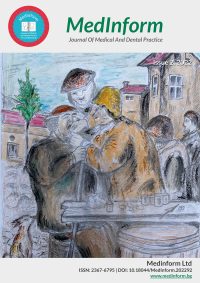Issue Two 2022
2022, Vol. 9, issue 2, (September)
Case Reports
Chemical-Mechanical Removal Of Infected Dentin in caries treatment
Abstract:
In the last year is most important to keep the vitality of the dental pulp because when it is necessary to make endodontic treatment, results are only sometimes predictable. Most authors take care of indirect and direct pulp treatment and vital pulp therapy. The important question is how to remove the infected dentin. The ways that show preventing the affected layer of dentin are interesting. The aim is to investigate removing infected dentin and keeping affected dentin in clinical cases of deep caries lesions and hyperemia pulpae with chemical-mechanical medication of papain gel (Brix 3000).
There are described of two clinical cases. The first one is with diagnoses of caries profunda. The results of removing infected dentin only with papain gel have given possibilities to prevent the opening of the pulp. The second case is with a diagnosis of hyperemia pulpae. With CBCT, an investigation has established that the distance to the pulp was about 0.6 mm. Using the method of chemical-mechanical removal of infected dentin with papain gel, we did not have direct communication with the pulp. Today, published literature confirms that the preparation with rotary burs is harmless, non-irritating, and non-damaging to healthy tissues in the oral cavity. Brix 3000® successfully removes infected dentin without affecting the affected one in the carious lesion. This is fully in line with the modern concept of minimally invasive dentistry. The lack of pain, overheating, vibration, and noise, and the biological and gentle action towards the dental pulp when applying to make it an indispensable assistant to the dentist in children and adolescents, as well as in adult patients.
Keywords: chemical-mechanical removing of caries; papain gel; Brix 3000; infected dentin; affected dentin; ozone treatment.

